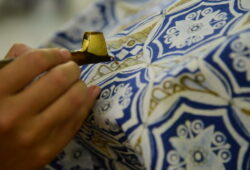Pointillism: A Pioneering Art Movement of Dots and Colours
 Posted On
Posted On
Pointillism, a revolutionary art movement that emerged in the late 19th century, sought to redefine the boundaries of traditional artistic techniques. Through meticulous application of small, distinct dots of pure colour, this movement transformed the world of visual arts, offering a unique and mesmerizing approach to artistic expression. In this article, we will delve into the origins, key characteristics, and notable artists of Pointillism.
Origins and Development: Pointillism, also known as Divisionism or Neo-Impressionism, was founded by the French artists Georges Seurat and Paul Signac during the 1880s. Inspired by the works of Impressionist painters like Claude Monet and Camille Pissarro, Seurat and Signac sought to challenge the limitations of Impressionism by introducing a systematic technique for applying colour to canvas.
Key Characteristics: At the heart of Pointillism lies the meticulous and calculated placement of small, individual dots of colour on the canvas. Artists believed that by juxtaposing pure, unmixed colours, the viewer’s eye would naturally blend them together, creating an optical illusion of vibrancy and depth.
Pointillist painters often used scientific colour theories, such as the work of chemist Michel Eugène Chevreul and the colour wheel, to guide their compositions. This scientific approach allowed them to achieve precise colour combinations and contrasts, heightening the visual impact of their artwork.

The technique demanded immense patience and dedication, as creating a single Pointillist painting required thousands of tiny dots. Despite its labour-intensive nature, this method became the defining characteristic of the movement, setting it apart from traditional art practices.
Notable Artists and Their Contributions: Georges Seurat (1859-1891): As the co-founder and pioneer of Pointillism, Seurat’s most renowned work, “A Sunday Afternoon on the Island of La Grande Jatte” (1884-1886), epitomizes the movement’s technique. The masterpiece showcases Seurat’s meticulous dots, capturing scenes of leisure and daily life.
Paul Signac (1863-1935): Alongside Seurat, Signac played a crucial role in popularizing Pointillism. His artwork “The Port of Saint-Tropez” (1899) and “The Pine Tree at Saint Tropez” (1909) showcase the movement’s focus on maritime themes and the vivid interplay of colours.
Vincent van Gogh (1853-1890): Although not a strict Pointillist, van Gogh was influenced by the movement and incorporated its principles into some of his works, notably “Starry Night” (1889), where he experimented with the technique to achieve a vibrant, pulsating night sky.
Legacy and Impact: Pointillism’s influence extended beyond the late 19th and early 20th centuries, inspiring subsequent generations of artists and movements. Its emphasis on colour theory, optical blending, and meticulous attention to detail laid the groundwork for the development of modern art, including Neo-Impressionism and various strands of abstract art.
Furthermore, Pointillism served as a bridge between the Impressionist and Fauvist movements, as artists like Henri Matisse and André Derain adopted aspects of Pointillism’s colour theory while pushing the boundaries of artistic expression.
Pointillism, with its innovative technique of using individual dots to create stunning compositions, remains an enduring and influential art movement. The meticulous approach of its pioneers, Georges Seurat and Paul Signac, transformed the art world, leaving a lasting legacy on modern art practices. Pointillism’s focus on colour theory, precision, and optical effects continues to captivate artists and art enthusiasts alike, making it a truly revolutionary chapter in the history of visual arts.



